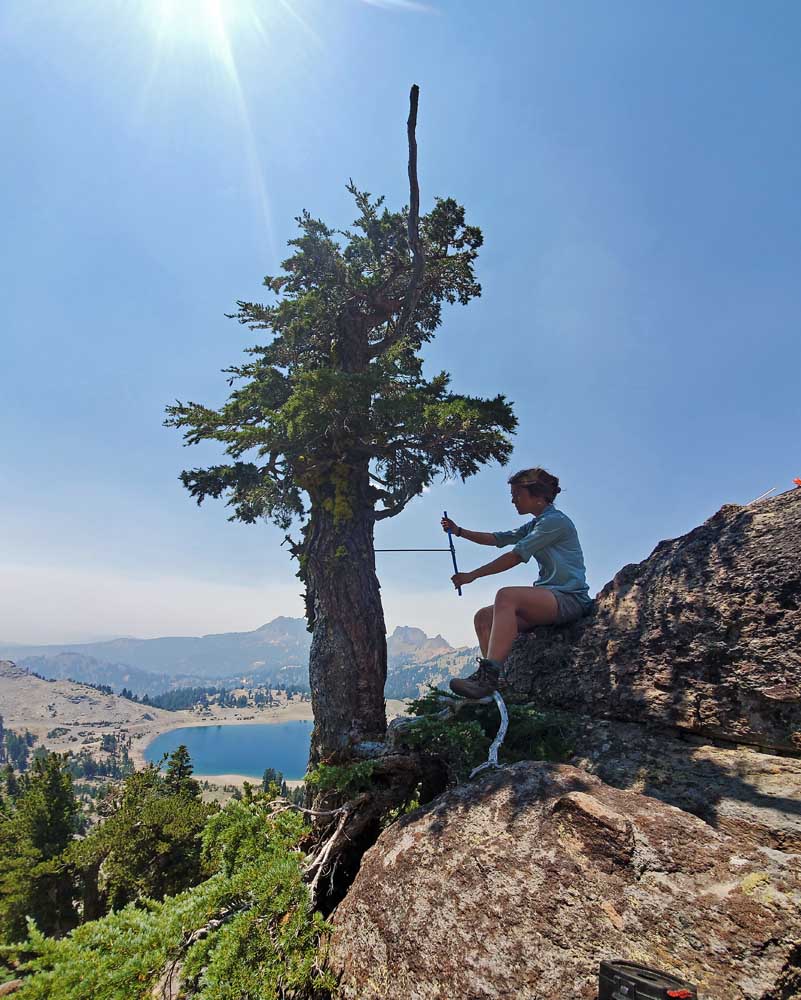Study says West’s 2-decade drought linked to climate change
Published 11:16 am Wednesday, January 24, 2024

- Karen King using a 5-millimeter-hand-increment borer to collect a sample from mountain hemlock at Lassen National Park, in California, in 2021. Samples from this collection were processed for blue intensity and are a part of the Western North American Temperature Atlas.
For the past several summers, Karen King crisscrossed the western United States in search of trees.
Using a hand-cranked drill, she bored into towering spruces high in the Rockies, Sierra Nevada and other mountains to unsheathe blocks of wood. She wanted to learn about the region’s past dry spells — to understand the current “megadrought” gripping the region.
“Your left bicep is a lot larger than your right bicep by the end of the summer,” said King, an assistant professor at the University of Tennessee at Knoxville. “I’m not kidding.”
All that hand-cranking paid off in a paper published Wednesday in the journal Science Advances. She and her colleagues found the West’s two-decade drought is inextricably linked to climate change, adding to the evidence that human-caused emissions are reshaping the region in profound ways.
The study is part of an emerging field of tree-ring science squeezing more information than ever out of wood to understand past climates and prepare for what is to come as human keep pumping heat-trapping gases into the atmosphere.
“Our findings now demonstrate that the record high temperatures driving recent ‘hot droughts’ are indeed unique and the human fingerprint on these events implicates us in their intensity and their consequences,” said Kevin Anchukaitis, a professor at the University of Arizona who co-authored the paper with King.
Drilling deep into the past
As a tree grows thicker and taller each year, conditions outside its bark make indelible marks within. Scientists like King — called dendrochronologists — study tree rings to decipher the climates of ages before formal record keeping, when trees were the sole sentinels.
During especially warm summers, cells of spruces and other trees build dense cell walls to retain water. By measuring the density of that dark “latewood” formed toward the end of growing season, researchers can infer the high temperatures of ancient summers.
So King and her colleagues sampled cores from dozens of high-elevation spruces, hemlocks and firs from British Columbia to New Mexico. The COVID outbreak in 2020, when King was finishing a Ph.D. at the University of Idaho, didn’t slow her down after campus closed.
“It was actually a blessing in disguise,” King said. “We got in the car, and we just drove around and collected cores all summer.”
“It was a really cathartic way to deal with the pandemic,” she added. “We were social-distancing in the middle of nowhere.”
Back in the lab, scientists shone a blue light on samples to measure the wood’s density. The data, coupled with other data from X-ray scans of tree cores, allowed them to reconstruct summer-high temperatures dating back to the year 1553.
The ‘human fingerprint’ in the trees
For years, researchers have known human-caused warming is making the current megadrought in the naturally drone-prone western United States worse. Past research on tree rings, which reconstructed soil moisture levels, found the region hasn’t been this dry for this long since the 16th century.
But until now, what was less clear was the role of temperature in past dry spells. Were they due to excessive heat, or just a lack of precipitation? “We were unable to disentangle the potential role of temperature in past megadroughts, which were severe events that occurred naturally,” Anchukaitis said.
In the new study, the team found that lengthy droughts in the past, such as a 22-year one that hit the region in the late 16th century, were not necessarily hotter than normal.
By contrast, the team found the period from 2000 to 2020 to have been the warmest two-decade span of the past half-millennium across much of the West, including the Southwest and Pacific Northwest. In the Great Plains, the period ranks second behind the Dust Bowl era during the Great Depression.
“Modern megadrought conditions are in fact warmer and more influenced by warming temperatures than in the past,” King said.
‘Buckle up’
So far, the megadrought’s consequences have been severe.
One of the region’s arteries, the Colorado River, which serves 40 million people, is in crisis after reservoirs fell to dangerously low levels, prompting the Biden administration to step in to conserve water. This summer, Phoenix recorded the hottest month ever observed in an American city, with hospitals treating victims burned by pavement.
Brad Udall, a water and climate research scientist at Colorado State University, noted the new research confirms past work showing the current “hot drought” is historically unusual.
“This study provides yet another depressing look at how and why human-caused climate change is affecting the American West. In short, high temperatures create more intense droughts,” said Udall, who was not involved in the study. “My simple advice for Western water and land managers: buckle up. The fires and droughts of the last 20 years are going to get much worse, given current greenhouse gas emission trends.”
For King, the crisis today is all the more reason to probe trees for clues about past climates.
“Why study the past?” she said. “It’s the idea that we can learn from the past and use our observations of trends and values to understand future risk.”
“That’s really the value of what we do.”
The team found the period from 2000 to 2020 to have been the warmest two-decade span of the past half-millennium across much of the West, including the Southwest and Pacific Northwest. In the Great Plains, the period ranks second behind the Dust Bowl era during the Great Depression.








